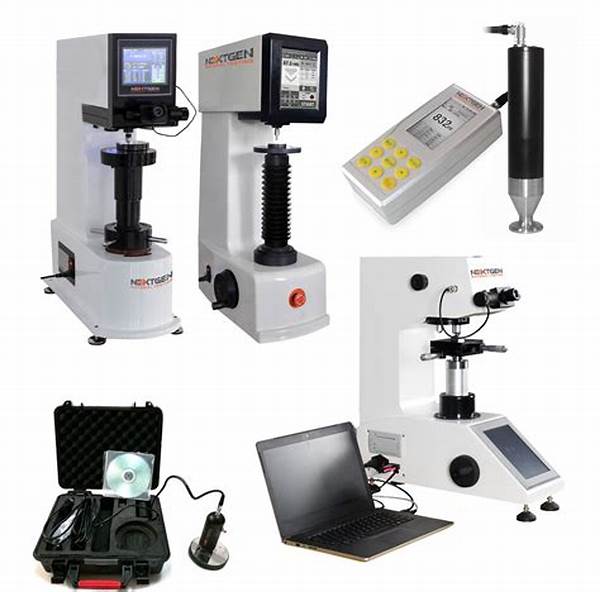In an era where the integrity and resilience of materials play a critical role in industrial advancements, the art and science of measuring material hardness have become crucial. Imagine a world without bridges, skyscrapers, or vehicles all reliant on the assurance that their construction materials are robust enough to withstand the tests of time and use. Material hardness testing instruments sit at the heart of ensuring that the dreams of architects and engineers do not crumble into tales of defeat. Let’s explore why these instruments are not just tools, but the unsung heroes of modern construction and manufacturing.
Do you ever wonder how an ordinary piece of metal turns into the backbone of towering structures or the inner workings of a high-speed train? Dive into a world where every tap, pressure, and measurement contribute to making some of the safest and most efficient industrial creations. Material hardness testing instruments might not have the glamorous spotlight of tech gadgets, but they boast the power to uphold safety standards and enhance manufacturing processes. From casual DIY enthusiasts to top-tier industrial giants, everyone desires a testing process that is both precise and reliable — and that’s where these instruments shine.
Types of Material Hardness Testing Instruments
Material hardness testing instruments are the sentinels of structural integrity, ensuring that materials used in various sectors, such as construction, automotive, and aerospace, meet the required standards of durability and resistance. The thrilling aspect of these tools is the diversity they offer, catering to different testing scenarios with an array of methodologies.
The Intricacy of Rockwell Hardness Testers
Rockwell hardness testers are often the go-to instruments for measuring the hardness of metals due to their efficiency and speed. By assessing the depth of indentation under a large load over a specified period, these testers provide a direct hardness number — saving time while offering precise results. Picture them as the Netflix of material testers: quick, accessible, and never one’s to compromise on quality.
Brinell and Vickers Testers: When Precision Matters Most
Brinell testers are revered for their simplicity and practical application, used primarily for testing materials with coarse or rough surfaces. They are like the versatile chef in a kitchen, always ready to tackle a wide range of material “recipes.” Vickers testers, on the other hand, cater to the need for extreme precision, particularly when dealing with small or thin materials. It’s like choosing between a classic novel and a science fiction thriller; both serve different tastes but never disappoint.
Advancements with Non-Destructive Testing “ND” Methods
While traditional hardness testers leave a mark that could render a part unusable, non-destructive testing methods have revolutionized the material testing industry. Utilizing ultrasonic waves or electromagnetic fields, these advanced testers promise the integrity of the material remains, while still offering incredibly reliable results. They are the James Bond of the testing world — quick, discreet, and undeniably effective.
Key Features of Material Hardness Testing Instruments
Understanding these instruments requires delving into the key features that drive their demand in industries globally. Let’s unravel the elements that make them irreplaceable in the toolkit of any engineer or manufacturer.
Engaging and Empowering Industries with Material Hardness Testing Instruments
Material hardness testing instruments serve as both an oracle and a watchtower in industries, consistently providing valuable insights and ensuring compliance with quality standards. Consider the automotive industry, reliant on these devices to test engine components and frames to prevent catastrophic failures. In construction, the ability to accurately measure the hardness of steel ensures the structural integrity of buildings.
Read More : Organ Musical Instrument Integrated With Modern Midi Technology
As technology continues to evolve, so do these instruments, integrating advanced software and digital displays, which enhance their functionality even further. Furthermore, testimonials from numerous industries stand as a testament to their pivotal role in maintaining product integrity, enhancing performance, and reducing the risk of failure.
In Conclusion: Harnessing the Potential of Material Hardness Testing Instruments
In conclusion, material hardness testing instruments continue to underpin the security and effectiveness of numerous industries worldwide. Acting as the silent guardians, they ensure materials meet the stringent benchmarks necessary to innovate safely. Their role transcends mere measurement, becoming a fundamental component of lean manufacturing, quality assurance, and safety protocols.
A Final Word on Material Hardness Testing Instruments
Imagine a world where materials spoke, told their tales, and indicated their readiness for use. Material hardness testing instruments do just that — they are the voice of materials in engineering, epitomizing reliability and accuracy. With innovations continually improving their competencies, their future promises greater precision, facilitated workflows, and expanded capabilities. Whether you are an engineering veteran or a material testing novice, embracing these instruments opens doors to trust, quality enhancement, and product excellence.
For anyone looking to understand, delve into, or articulate the true value of their materials, engaging with material hardness testing instruments is not merely a recommendation; it is an invitation to elevate their work to unparalleled standards.
